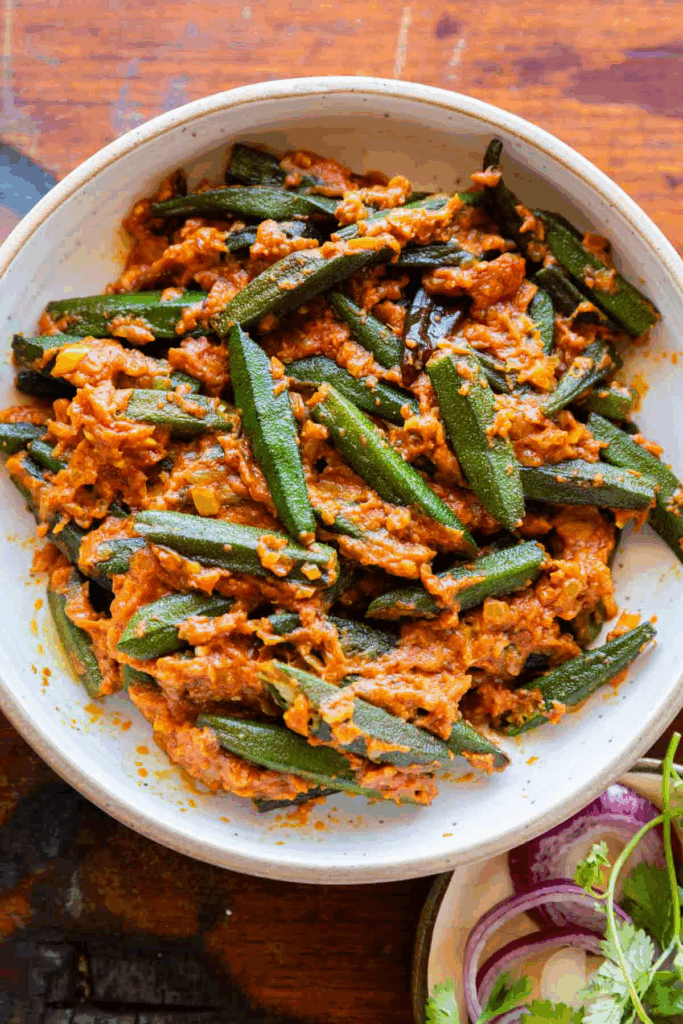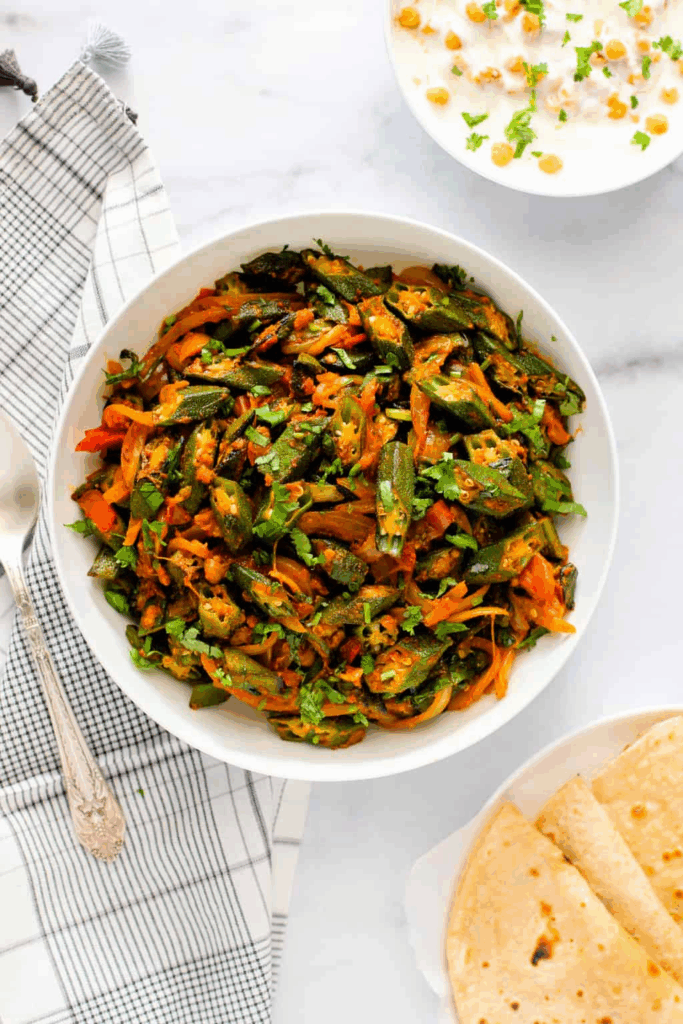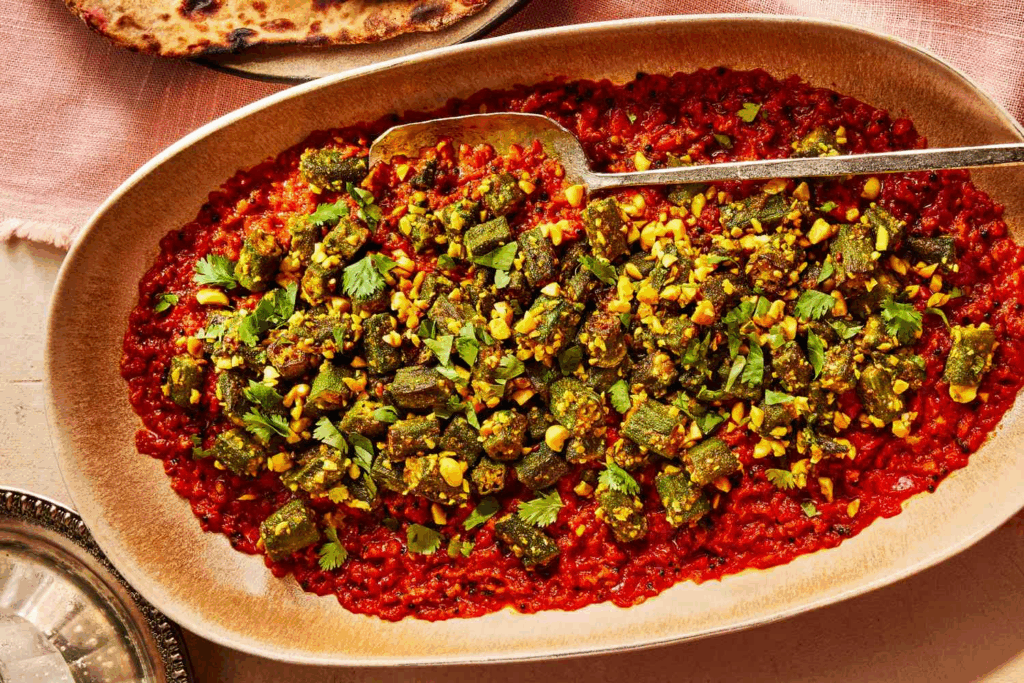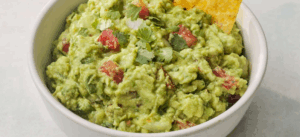What is Bhindi Masala and How to Cook Okra

Bhindi Masala is one of those dishes that truly showcases how humble vegetables can become stars in Indian cuisine. As a professional chef, I’ve cooked it hundreds of times—at home, for catering, and even in upscale restaurants where guests requested something comforting and homemade. It’s a North Indian dry-style preparation using okra (bhindi), cooked with onions, tomatoes, and a blend of spices that brings out its earthy and slightly grassy character. The secret is knowing how to manage the sliminess of okra—once you master that, the rest becomes joyful.
- Choosing the Right Okra for Bhindi Masala
- Core Ingredients for Traditional Bhindi Masala
- Cooking Time Table for Bhindi Masala
- Regional and Personal Variations of Bhindi Masala
- How to Avoid Sticky Okra: Chef’s Tips
- Microwave and Oven Methods for Bhindi Masala
- Pairing Bhindi Masala with Main Dishes
- Best Oils and Spices to Use
- How to Store and Reheat Bhindi Masala
- Cooking Bhindi Masala in a Slow Cooker
- Nutritional Profile and Cooking Time
- When to Add Tomatoes and Sour Elements
- Making Bhindi Masala for a Crowd
- Vegan and Gluten-Free Adaptations
- Final Thoughts from My Kitchen
- FAQ

Choosing the Right Okra for Bhindi Masala
The very first thing I always emphasize to my apprentices: never compromise on okra quality. When you’re selecting bhindi, look for small to medium pods—tender, bright green, and without blemishes. Avoid large pods; they’re often woody and less flavorful.
In my kitchen, I check freshness by snapping the tip of the pod—it should break cleanly without resistance. If it bends, it’s too old. I also dry them thoroughly after washing; wet okra is a slimy disaster waiting to happen. Pat them dry or air-dry them on a kitchen towel before chopping.
I prefer cutting them into 1-inch pieces, neither too thin (which can make them soggy) nor too thick (which can slow down cooking). If you want to make a perfect Bhindi Masala, the preparation begins long before the spices hit the pan.
Core Ingredients for Traditional Bhindi Masala
From my pantry to yours, here’s the heart of Bhindi Masala—ingredients that deliver that authentic North Indian flavor. I always follow this foundation when cooking for clients or family.
- Fresh okra (bhindi) – 400g, washed and dried
- Onions – 2 large, thinly sliced
- Tomatoes – 2 medium, chopped
- Ginger-garlic paste – 1 tablespoon
- Green chilies – 1–2, slit lengthwise
- Mustard seeds – ½ teaspoon
- Cumin seeds – ½ teaspoon
- Turmeric powder – ½ teaspoon
- Red chili powder – ½ teaspoon
- Coriander powder – 1 teaspoon
- Garam masala – ½ teaspoon
- Amchur (dry mango powder) – ½ teaspoon (or use lemon juice)
- Salt – to taste
- Oil – 2 tablespoons (I usually go for mustard or sunflower oil)
Optional ingredients like kasuri methi (dried fenugreek leaves) or a pinch of hing (asafoetida) can add even more depth if you’re aiming for a restaurant-style finish.

Cooking Time Table for Bhindi Masala
| Process Step | Time Required | Notes |
| Washing and drying okra | 20 minutes | Ensure complete drying to avoid sliminess |
| Cutting vegetables | 10 minutes | Includes onions, tomatoes, chilies |
| Sautéing onions | 7–10 minutes | Cook until golden to bring out sweetness |
| Cooking okra (pre-sauté) | 10 minutes | Sauté separately to reduce slime |
| Combining ingredients | 5 minutes | Add tomatoes, spices, and okra together |
| Final simmer | 8–10 minutes | Stir occasionally until okra is tender and flavors are absorbed |
| Total Cooking Time | ~45–50 minutes | Perfect for a fresh home meal or prep for the week |
Regional and Personal Variations of Bhindi Masala
As someone who’s cooked across different Indian states, I’ve seen bhindi masala morph in the most delightful ways. In the north, especially in Delhi and Punjab, it’s usually made with onions and tomatoes sautéed until rich. In Gujarat, it’s drier, with a bit of besan (gram flour) to coat the okra.
I’ve personally experimented with stuffing okra with a masala mix of coriander powder, amchur, and chili, then lightly pan-searing each piece—a bit more labor-intensive but incredibly flavorful. In some South Indian homes, curry leaves and coconut are added for a deeper aroma.
For clients abroad, I’ve even adapted it into a semi-dry curry with cream and garam masala for a “korma-style” twist—ideal for those who love mild, aromatic gravies.

How to Avoid Sticky Okra: Chef’s Tips
If there’s one thing that makes or breaks Bhindi Masala, it’s how you handle the “slime.” Early in my career, I learned that moisture is the main culprit. My golden rule: never cover the pan when cooking bhindi. That traps steam and turns the dish into mush.
I also recommend sautéing the okra first by itself in a hot pan with a bit of oil—this dries the surface and stops it from getting gooey. Adding acidic elements like tomatoes or amchur too early? Big mistake. They react with the mucilage and make it worse.
A trick I picked up during a catering gig: sprinkle a teaspoon of lemon juice or vinegar at the very end. It adds tang and reduces any residual stickiness without dulling the spices.
Microwave and Oven Methods for Bhindi Masala
Yes, you can absolutely make a decent Bhindi Masala without the stovetop. I’ve done this for dorm students and busy working parents who wanted low-mess cooking.
Microwave Method:
Place chopped okra on a microwave-safe plate. Drizzle with a few drops of oil and cook uncovered for 8–10 minutes, stirring twice. Then, mix in sautéed onions, tomatoes, and spices. Microwave for 2–3 more minutes until flavors merge.
Oven Method:
Preheat to 200°C (390°F). Toss okra with oil and a pinch of turmeric. Roast for 20 minutes, turning halfway. Meanwhile, prep the masala base in a pan. Mix both just before serving. You get crispier okra this way, great for texture lovers.
These alternative methods won’t replace stovetop authenticity, but they’re lifesavers when time or equipment is limited.

Pairing Bhindi Masala with Main Dishes
I’ve paired Bhindi Masala with everything from plain roti to aromatic biryanis. But my all-time favorite? Hot phulkas or tandoori roti with a dollop of ghee. The dry texture of bhindi complements soft, warm breads perfectly.
For a light lunch, I often serve it with plain curd rice or jeera rice. For a more festive option, I go with a mildly spiced Indian Pulao rice—they balance each other out beautifully.
For traditional South Indian thali presentations, Bhindi Masala sits between sambar, rasam, and a yogurt-based curry, bringing a dry-texture contrast to an otherwise saucy meal.
Best Oils and Spices to Use
Over the years, I’ve experimented with every oil you can think of—ghee, coconut oil, olive oil, mustard oil. For the most traditional flavor, mustard oil is my go-to. It gives the dish a sharp aroma that works beautifully with okra’s natural earthiness.
As for spices, it’s all about balance. I usually avoid heavy-handed garam masala unless I’m cooking a version with gravy. Instead, turmeric, coriander, red chili, and amchur form the holy quartet in my kitchen. For extra warmth, a pinch of cumin seeds and mustard seeds in the initial tempering layer in depth.
Sometimes I sprinkle crushed kasuri methi toward the end to finish the dish with a touch of bitterness—it’s not mandatory, but I find it elevates the entire plate.
How to Store and Reheat Bhindi Masala
Bhindi Masala is surprisingly storage-friendly if you cook it properly. I always tell people: let it cool completely before sealing it. Store it in an airtight container, and it’ll last up to 3–4 days in the fridge without getting soggy.
Reheating should be gentle. I recommend using a non-stick skillet and reheating over low heat. Avoid the microwave if possible—it tends to reintroduce moisture and soften the texture.
If you’re short on time and must microwave, loosely cover it with parchment paper, not plastic wrap. I’ve done this many times for corporate lunches, and it holds up well with the right prep.
Cooking Bhindi Masala in a Slow Cooker
Can you make Bhindi Masala in a slow cooker? Yes—but you’ll need to tweak your expectations a bit. I’ve tested this method while running outdoor events where stovetops weren’t an option.
What I do is lightly fry the okra and onions beforehand (preferably in a pan), then add all ingredients into the slow cooker, including tomatoes and spices. Set it on low for 2.5 to 3 hours, stirring once halfway through.
The slow cooking method yields a softer texture, almost stew-like. I often serve it as part of a mixed vegetarian platter with rice, dal, and curd—a nod to southern comfort food. (Ссылка: How to make Idli and sambar at home.)
Nutritional Profile and Cooking Time
| Nutritional Element | Value per Serving (approx.) | Notes |
| Calories | 150–180 kcal | Depends on oil and portion size |
| Protein | 2–3g | From okra and optional additions |
| Carbohydrates | 8–10g | Mostly from vegetables |
| Dietary Fiber | 3–4g | Bhindi is naturally high in fiber |
| Fat | 10–12g | Varies with oil type and quantity used |
| Cooking Time (stovetop) | 40–50 minutes | From prep to finish |
| Cooking Time (oven) | 30–35 minutes | Including roasting time |
| Cooking Time (microwave) | 12–15 minutes | For quick prep |
| Cooking Time (slow cooker) | 2.5–3 hours | Softer, stew-like version |
When to Add Tomatoes and Sour Elements
This is something I learned through trial, error, and a few ruined batches—timing is everything with tomatoes. Add them too early and they release water, making the okra soggy. Add them too late and they don’t bind with the spices.
I usually sauté the onions until golden, then add spices and let them bloom for a few seconds. Only then do I stir in the tomatoes and cook them just until soft—not mushy. The okra should be added last, so it maintains its firmness and lightly fries instead of stews.
Sourness, whether it’s from amchur, tamarind, or lemon juice, is best introduced in the final few minutes. This preserves brightness and avoids over-acidifying the dish. When I serve it as part of a South Indian meal, I often include Idli and sambar—which adds softness and tang that contrast beautifully with okra’s texture.
Making Bhindi Masala for a Crowd
When catering for 20, 50, or even 100 guests, I approach Bhindi Masala very strategically. First, I pre-cook the okra in batches, shallow-frying it until just crisp. Then I prepare the onion-tomato masala separately in a large flat-bottomed pan.
I don’t combine everything until close to serving. This avoids the okra breaking down or turning mushy from extended steaming. If I need to hold it warm, I use chafing dishes lined with banana leaves—they help absorb moisture and prevent sticking.
For large portions, scaling up the spices is not linear. I increase turmeric, cumin, and chili carefully, but never multiply salt directly—it’s better to adjust near the end after tasting. I sometimes serve it alongside rich Korma curry for contrast and creaminess.
Vegan and Gluten-Free Adaptations
Bhindi Masala is naturally vegan and gluten-free, which makes it a brilliant dish for dietary-sensitive guests. I’ve served it at weddings, yoga retreats, and Ayurvedic workshops—always a hit.
Avoid any dairy toppings like ghee or yogurt garnishes. Also, double-check your spice blends if you’re using pre-mixed garam masala; some brands may include wheat starch or processed additives.
Want to boost the protein? Add sautéed tofu or black-eyed peas. I’ve even used cooked quinoa stirred into the masala for a high-fiber, fusion-style bowl. For a fully satisfying Indian thali, I often pair it with something light and aromatic like Indian Pulao rice.
Final Thoughts from My Kitchen
Bhindi Masala isn’t just a dish—it’s a skill test, a nostalgic memory, and a weekday hero. The more you cook it, the more your hands will understand the rhythm: when the okra starts browning, when the spices bloom, when the tomatoes melt just right.
If you’re a beginner, start with small batches and don’t rush. Let the process teach you. If you’re an experienced home cook, play with variations, add your own twist, or try pairing it with a subtle main like lightly spiced korma or soft idli with sambar—you’ll love the balance.
Bhindi has taught me patience, and Bhindi Masala continues to be one of my most requested dishes, both at home and on the road.
FAQ
What type of okra works best for Bhindi Masala?
From my experience, the best okra is young, tender, and small-to-medium in size. I avoid thick or overly mature pods because they tend to be woody and produce more slime. Freshness makes all the difference—you want okra that snaps cleanly when bent and has no dark spots.
How do I keep okra from becoming slimy when cooking?
I’ve tried many approaches, but what really works for me is patting the okra completely dry before slicing, and cooking it uncovered in hot oil until it sears. Stirring less also helps. Avoid adding water or covering the pan, which can trap steam and make things gooey.
Can I make Bhindi Masala without onions or garlic?
Yes, I’ve done it many times for friends who avoid alliums. The key is to use asafoetida (hing) for depth and a bit of extra tomato for body. The flavor profile changes slightly, but it’s still delicious and very fragrant if you toast your spices well.
What oil is best for frying okra in this dish?
I’ve experimented with everything from coconut oil to avocado oil, but neutral oils like sunflower or peanut oil give the best texture without overpowering the spices. For a traditional North Indian touch, mustard oil adds a subtle bitterness that works well.
Can Bhindi Masala be cooked in an air fryer?
Yes, and I do this quite often when I want a lighter version. I toss the sliced okra in a little oil and spices, then air-fry at 180°C (350°F) until crisp. After that, I quickly toss it in a prepared tomato-onion masala. The result is clean, crispy, and satisfying.
Is Bhindi Masala freezer-friendly?
On my own testing, I found that freezing changes the texture of okra—it gets softer and slightly mushy when thawed. I’d recommend preparing the masala base and freezing that instead. Cook the okra fresh for best results.
How can I reduce the oil in Bhindi Masala?
When I cook for clients who request low-fat meals, I bake or air-fry the okra instead of frying. I also sauté the masala with just a spoon of oil and use a nonstick pan. The dish won’t be as glossy, but the flavors still shine.
Can I serve Bhindi Masala with non-Indian sides?
I’ve paired it with quinoa, couscous, and even roasted sweet potatoes for fusion meals. The earthiness of okra and the bold spices translate surprisingly well. Just avoid heavily flavored sides that may clash with the masala base.
Why does my Bhindi Masala taste bitter?
Bitterness usually comes from overcooked garlic, burnt spices, or sometimes the okra itself if it’s old. I always cook garlic gently and never rush the masala. If bitterness happens, adding a pinch of sugar or extra tomato can mellow it out.
Can I use frozen okra?
Yes, but I always thaw it completely and blot it dry with kitchen towels. I’ve noticed that frozen okra releases more moisture, so you’ll need to fry it longer or use high heat. Don’t overcrowd the pan—it’ll just steam instead of crisping.
How spicy is the typical Bhindi Masala?
The spice level is totally up to you. Personally, I go medium-spicy with green chilies and red chili powder, but when I’m serving kids or spice-sensitive guests, I tone it down and focus more on the tang and aromatics.
What’s the ideal consistency of the masala?
In my kitchen, I aim for a thick and chunky masala that clings to each piece of okra. It shouldn’t be soupy. If it feels too wet, I just let it simmer uncovered for a few extra minutes until it thickens naturally.
Can I make Bhindi Masala in advance?
Absolutely. I often prepare it a few hours ahead, then reheat gently in a pan. Just don’t refrigerate it overnight unless you’re okay with slightly softer okra. If you’re meal-prepping, store the masala and okra separately, then mix before serving.
What’s the best way to reheat Bhindi Masala?
On my own stove, I reheat it in a nonstick pan with a splash of oil or water to loosen the masala. Avoid microwaving for too long—it can make the okra rubbery. Low heat and gentle stirring keep the dish fresh and textured.
Can I make Bhindi Masala for a festive meal?
Yes, and I have many times! Just elevate the dish with garnishes like crisp curry leaves, a dash of garam masala, or a squeeze of lemon before serving. Pair it with saffron rice or stuffed parathas, and it becomes a centerpiece-worthy option.




Post Comment